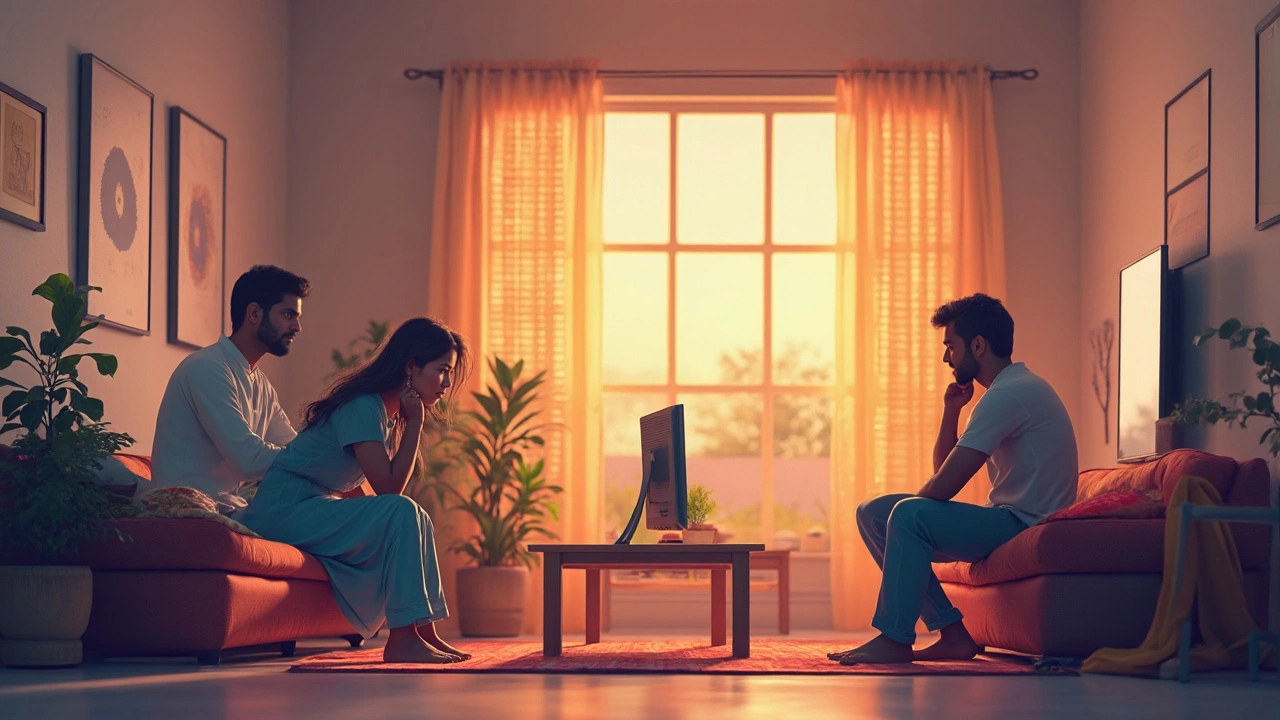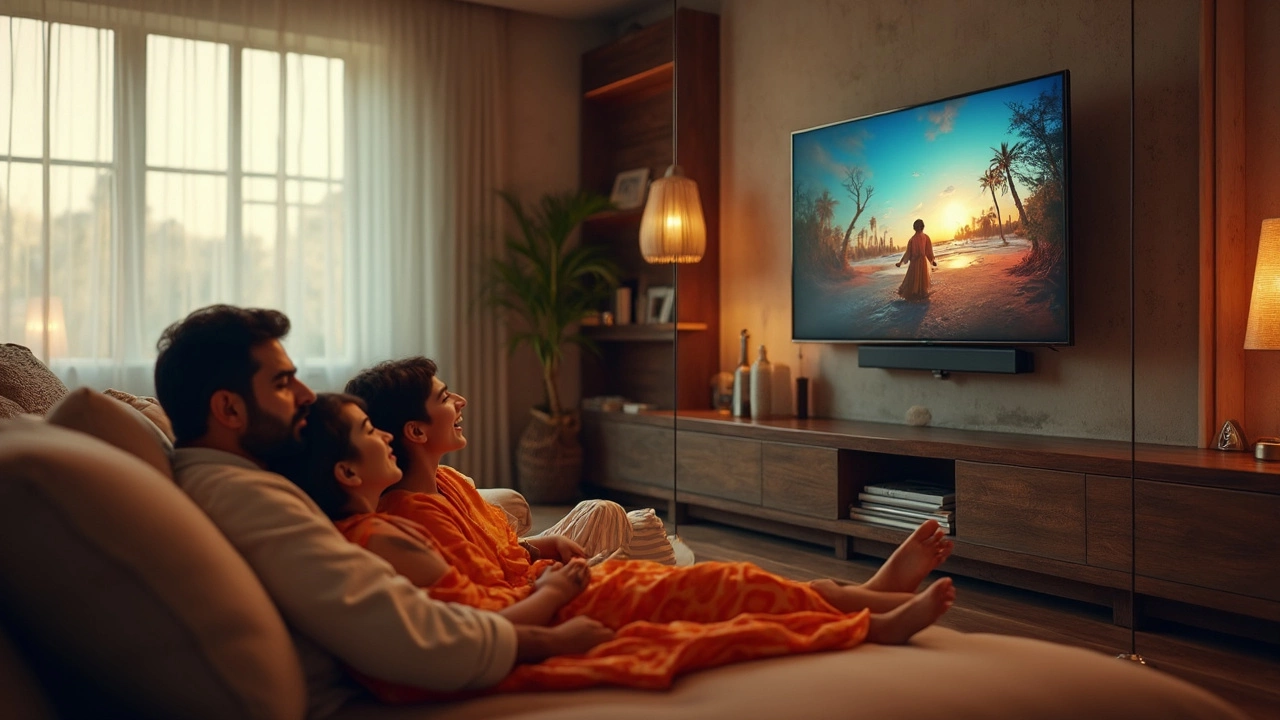If you’ve ever watched TV with a sore neck or squinted at a screen with a weird glare, your setup might be the problem. Tilting your TV down isn’t just a weird trend—it’s usually about comfort and getting the clearest picture.
Think about where you usually sit. If your TV is mounted too high—like above a fireplace—you end up looking up at the screen, which can get annoying fast. Tilting the screen down brings the TV’s “sweet spot” more in line with your eyes, making everything feel more natural. Plus, it helps cut down on glare from windows and lights, which messes up color and detail onscreen.
Wondering if it matters with a TV that’s just sitting on a stand? It still could, especially if the stand is higher than your couch or your seating area is unusually low. Even a few degrees of tilt can make movie nights way easier on your body and your eyes.
- Why Tilt Your TV Down?
- Common Mistakes with TV Placement
- How Much Should You Tilt?
- Tips for the Best Viewing Angle
- What to Avoid When Tilting Your TV
Why Tilt Your TV Down?
Most people don’t realize how much the angle of their TV affects their viewing experience. When your TV isn’t aimed at your eyes, you can end up with everything from a stiff neck to a washed-out screen. That’s where the question, tilt tv down or not, really matters.
Here’s the deal: Modern TVs, especially LED and LCD screens, look brightest and sharpest when you’re basically staring at them straight on. TV experts call this the “center viewing angle.” If your set is much higher than your eyes—say, it’s mounted up on a wall—you’re seeing it from below. That can mute colors and make dark scenes even harder to watch. The solution is simple: tilt tv down toward where you’re sitting.
It’s not just about the picture, either. Sitting on your couch and craning your neck up for hours is basically asking for aches and pains. The American Chiropractic Association even recommends keeping screens at eye level or tilted slightly toward your line of sight to lower the risk of pain over time.
There’s another bonus: A downward tilt tv angle helps with glare and reflections. Sunlight bouncing off your windows or lights overhead can turn your screen into a giant mirror. Tilted TV mounts break up that glare, so you see more of the show and less of your own reflection.
- If your TV is mounted above a fireplace, tilting down is almost always a must.
- Even stands can benefit from a slight tilt if your seat is much lower than the TV.
- Many tilt mounts offer a range, usually about 5–15 degrees, so you have options for comfort.
So, if you want better color, less glare, and no post-binge neck pain, try a slight tilt the next time you set up your TV. Small angle, big difference.
Common Mistakes with TV Placement
A sloppy setup can ruin your viewing experience, no matter how expensive your TV is. People make a few repeat mistakes all the time. The most obvious screw-up is mounting the TV too high. You see this a lot over fireplaces or on tall dressers. If your eyes aren’t roughly level with the middle of the screen, you’re probably going to get a stiff neck sooner or later. Experts have found that having the center of the TV about 42 inches from the floor lines up with the average eye level when you’re sitting.
- Tilt TV brackets get ignored or skipped. That’s a missed opportunity for a simple comfort boost.
- Propping your TV on narrow or wobbly stands is risky and looks messy. One bump and you’re shopping for a replacement.
- Don’t forget about glare. If sunlight hits the TV during prime-time hours, you’re not going to see much. Position your screen so windows or lights aren’t bouncing off it.
- Not using proper cable management. This isn’t just about looks—dangling cords can pull or tip your gear.
- Squishing the TV into a corner or too close to the wall actually traps heat. These things need space to breathe to avoid overheating.
Check out this rundown of typical placement heights versus comfort:
| TV Placement | Avg. Height from Floor (inches) | Comfort Rating |
|---|---|---|
| Wall Mount (eye level) | 42 | Best |
| Above Fireplace | 55+ | Poor |
| On Tall Dresser | 48-52 | Fair |
If you’ve made any of these mistakes, you’re definitely not alone. Focusing a bit more on placement and making use of a tilt tv feature can fix most issues fast.

How Much Should You Tilt?
It’s easy to overthink this, but you don’t need to break out any crazy math. The best angle for most setups is a tilt of about 10 to 15 degrees. That range keeps your eyes relaxed and puts the center of the screen closer to eye level, which is what your neck (and back) want.
Say your tilt tv wall mount gives you an option—start with 10 degrees down if you’re sitting at a normal height on your couch. If your TV is really high up, you might find that 15 degrees feels more comfortable. Trust how your neck feels after an hour of binging a show—if it still feels good, you nailed it.
Manufacturers like Samsung and Sony often recommend aiming for the middle of the screen to line up with your eyes from your main seating spot. There’s a reason most movie theaters have those slight downward angles—the same thing works at home for your tv stand.
If you want some quick guidelines, try this:
- For TVs mounted higher than 42 inches from the floor, start with a 10-15 degree tilt.
- If your tv down tilt exposes the screen to window light, check for glare and adjust back a bit.
- Sit in your normal spot and look at the middle of the screen—if you’re straining or nodding your head, tweak the tilt up or down.
One study by the Society of Motion Picture and Television Engineers found that a vertical viewing angle of 15 degrees or less is most comfortable for long viewing. Most people pick something in that ballpark without realizing it. Here’s a quick reference:
| TV Height from Floor | Recommended Tilt Down |
|---|---|
| Up to 40 inches | 0–5 degrees |
| 41–55 inches | 10–12 degrees |
| 56 inches or higher | 13–15 degrees |
Don’t worry about being exact—a small adjustment can make a huge difference in comfort. The goal is simple: you want the center of your TV at eye level, and a tilt tv setup gets you closer to that even when it’s mounted high.
Tips for the Best Viewing Angle
Getting the viewing angle right can turn a so-so TV setup into the best seat in the house. You don’t need fancy tools—just a little measuring and tweaking.
- Eye level matters: The ideal spot for the center of your TV is right at eye level when you’re sitting down. If you tilt your TV down, aim for the middle of the screen to line up with your eyes. Most people feel comfy when the center is about 42 inches from the floor to their eyes if they’re on a couch.
- Angle it 10-15 degrees: Experts often suggest tilting your TV down by 10 to 15 degrees if it’s mounted higher than eye level. It’s just enough to help prevent neck strain without looking odd.
- Managing glare: Tilting your TV down can really help if you fight with glare. Test it: wait until the sun hits your living room or overhead lights are on, then slowly adjust your TV until reflections disappear.
- Get help if you can: It’s easier to adjust a big TV with two people, especially for larger screens. One can hold while the other checks the angle and tightens the bracket.
- Distance counts: The size of your TV and how close you sit matter too. Here’s a quick cheat sheet:
| TV Size | Sitting Distance | Best Tilt |
|---|---|---|
| 50-55" | 6-8 feet | 10°-15° |
| 65-75" | 8-11 feet | 5°-10° |
Last thing—lock down those cables after you finish adjusting so the TV stays put and looks tidy. No one likes a dangling wire doing its own thing behind the screen.

What to Avoid When Tilting Your TV
Ready to angle your screen? Before you grab the screwdriver, there are a few things you shouldn’t do if you want the best tilt tv setup and to avoid expensive mistakes.
- Don’t Over-Tilt: Most mounts suggest tilting no more than 10-15 degrees. More than that and you risk both picture distortion (the image looks weird or colors shift) and major neck strain.
- Never Ignore the Mount’s Weight Limits: Every bracket has a max TV size and weight. Exceed that, and your TV stand or wall could give way—bad news for your screen and your wall.
- Watch Out for Loose Screws: Fight the urge to leave hardware half-tightened. A few missed turns now, and your TV could slowly sag or even fall after a few weeks.
- Don’t Block Your Ports: Tilting often makes cables harder to reach or pushes the back of the TV close to the wall. Double-check you can actually plug things in before you finish.
- Never Skip the Level: Even a slightly crooked screen throws off your viewing angle. Double-check with a level—don’t trust your eyes alone.
Fun fact: According to a 2023 survey from CNET, one in five people who wall-mount their TV have to reposition it at least once because they misjudged the viewing angle or blocked a port.
Last thing—don’t guess on the floor-to-eye distance. The center of your tv down screen should line up with your eye level when sitting. If you tilt too much or too little, you’ll regret it during a long binge session.

